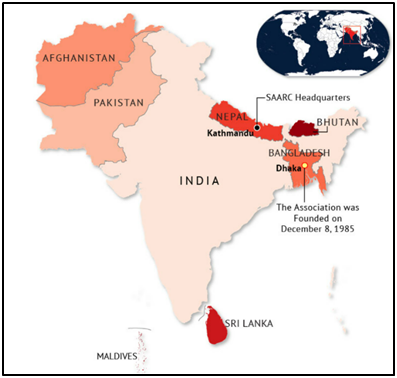Why in the News?
The Reserve Bank of India (RBI) has decided to put in place a revised Framework on Currency Swap Arrangement for SAARC countries for the period 2024 to 2027.
What’s in Today’s Article?
- About SAARC (Objectives, Members, Structure, etc.)
- Currency Swap Agreement (Meaning, Benefits, India’s Agreements, etc.)
- News Summary
About SAARC:

- The South Asian Association for Regional Cooperation is the regional intergovernmental organization and geopolitical union of states in South Asia.
- It was established with the signing of the SAARC Charter in Dhaka in 1985.
- The SAARC includes eight south Asian countries: Afghanistan, Bangladesh, Bhutan, India, Maldives, Nepal, Pakistan, SriLanka
- There are currently nine countries with ‘Observer’ status: Australia, China, European Union, Iran, Japan, South Korea, Mauritius, Myanmar, United States of America
SAARC Structure:
- SAARC Summits:
- The Meetings of the Heads of State or Government of Member States is the highest decision-making authority under SAARC.
- Summits are usually held biennially hosted by a Member State in alphabetical order.
- The Member State hosting the Summit assumes the Chair of the Association.
- Council of Ministers:
- Council of Ministers (CoM) comprises of the Ministers of Foreign/External Affairs of the Member States.
- The Council meets, preceding the Summit and between the two summits.
- The Council has also been meeting informally, since 1997, on the side-lines of the United Nations General Assembly Sessions in New York.
- Secretariat:
- The SAARC Secretariat was established in Kathmandu on 16th January 1987.
- Its role is to coordinate and monitor the implementation of SAARC activities.
Decision-making:
- Decisions at all levels are to be taken on the basis of unanimity.
- Bilateral and contentious issues are excluded from the deliberations of the Association.
About Currency Swap Agreement:
- A currency swap agreement is a financial contract between two parties to exchange principal and interest payments in different currencies.
- The primary purpose of such an agreement is to secure more favourable loan terms or to hedge against currency risk.
- Features of currency swap agreement include:
- Exchange of Principal:
- At the start of the swap, the two parties exchange equivalent amounts of different currencies based on the prevailing exchange rate.
- For example, Party A might lend Party B USD, while Party B lends Party A an equivalent amount in INR.
- Interest Payments:
- Throughout the duration of the swap, the parties exchange interest payments on the borrowed amounts.
- These payments are typically made at regular intervals and are calculated based on the interest rates agreed upon in the swap contract.
- The interest payments can be fixed or floating rates.
- Re-exchange of Principal:
- At the end of the swap agreement, the parties re-exchange the principal amounts at the initial exchange rate, regardless of the current exchange rate.
- Benefits of Currency Swap Agreements:
- Hedging: Companies can hedge against currency fluctuations and interest rate changes.
- Access to Capital: Firms can access capital in foreign currencies at more favourable rates.
- Cost Savings: It can lead to cost savings due to better loan terms in the foreign currency market.
India’s Currency Swap Agreements:
- So far, the Commerce Ministry, Government of India, has finalised arrangements with some 23 countries with whom Indian can trade in local currencies.
- In simple terms, the importer or exporter in both the countries has to quote and receive settlements in their own currencies.
- No third country currency is involved, thereby eliminating the need to worry about exchange variations.
- India's emphasis has been to persuade countries to come to this arrangement, where India has substantial or sizeable trade deficit with that country.
- By doing so, the dues are still payable in rupees, thus saving the need to settle in "foreign exchange" in say, US dollars, Euros, or whatever.
- Once the Finance Ministry approves the country with whom such an arrangement would be mutually beneficial, Commerce Ministry takes over the responsibility to start the bilateral talks to arrive at a suitable agreement.
Currency Swap Arrangement for SAARC countries:
- The Reserve Bank of India (RBI) announced a revised Currency Swap Framework for SAARC countries, effective from 2024 to 2027.
- This framework enables bilateral currency swap agreements between the RBI and SAARC central banks to address short-term foreign exchange liquidity needs or balance of payments crises.
- A new INR Swap Window with concessions for Indian Rupee support, totalling ₹250 billion, has been introduced.
- Additionally, a US Dollar/Euro Swap Window with a corpus of $2 billion will continue.
- All SAARC member countries can access the facility, provided they sign the bilateral agreements.









